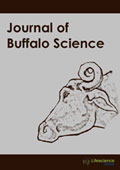jbs
|
|
Abstract: Omphalitis in domestic animals being considered as commonest ailment after birth, are in general, poorly reported for its uneventful recovery. Several previously reported cases endeavoured to highlight involvement of pathogenic organism in progression of the condition with little elaboration to pathologic changes occurred. Moreover, description of omphalitis in buffalo calf was never been attempted. Therefore this report intends to elaborate the pathology noted around umbilical zone in a buffalo calf possibly arisen to infectious etiology with special reference to complicated involvement of urachus, eventual haemoperitoneum and striking acute vascular changes of multi-systemic organs. Intriguingly, this report also attempted to review few recent cases of omphalitis seen in different animals along with their paramount etiologic causes. Keywords: Omphalitis, Urachitis, Pathology, Buffalo calf.Download Full Article |
|
|
Abstract: The domestic (water) buffalo is not indigenous to Africa. Some buffalo may have been taken to what is now Tunisia in Roman times about 2000 years ago. The species arrived in Egypt from Mesopotamia some 1200 years past and there were attempted introductions to the east coast of Africa by the Portuguese from India in the sixteenth century. The missionary-explorer David Livingstone took four buffalo from India to what is now southern Tanzania in 1866. In the twentieth century, European powers introduced buffalo to many of their African colonies. In addition to Egypt and Tunisia on the Mediterranean coast of north Africa buffalo have been introduced to fourteen subSaharan countries. Information on these introductions is sparse and is obviously incomplete. With the exceptions of Tanzania, where there have been buffalo for 90 years, and Mozambique, where there is documented presence over about 50 years, buffalo have been present for very short periods. They have disappeared without trace in some countries and have been culled in others due to adaptation or disease problems. Suitable ecological niches for buffalo exist in many African countries. Too few animals, failure to provide sufficient public financial resources and lack of private sector interest are among the reasons for the buffalo’s failure to contribute to African livestock production. Keywords: Introductions, exotic animals, domestic livestock, animal disease, adaptation.Download Full Article |
|
|
Abstract: In the current scenario the most of people are well aware with health issues. Food safety is generally related with the quality of food i.e. whether the food product is standardised as according to national or international norms set by the statutory organisations. People can compromise with the nutritive values of food but not with their safety aspects. The meat and meat products carry the burden of harmful agents according to the production methods. Now-a-days the feedlot animals are being reared either through the natural farming (organic farming) or conventional farming method. Those methods produce safe and healthier meat because there is no use of harmful chemical agents’ viz., pesticides, herbicides, hormones, growth promoters, veterinary drugs and etc. On the other hand, in the conventional farming, all these chemical agents are used to enhance animal growth. Several chemical agents like pesticides and veterinary drugs residues may cause harmful health implications viz., teratogenicity, carcinogenicity, hypersensitivity reactions, gut bacterial resistance, toxicity and many more health problems in human beings. It is the thrust of today to replace the conventional meat with the organic meat to check the use of harmful chemical agents for a healthy social life. Keywords: Meat, organic farming, conventional farming, food safety.Download Full Article |
|
|
Abstract: A case of suspected wild boar death due to dynamite blast by poachers was received by us for confirmation. The skin sample was collected and examined histologically for identification based on hair follicle arrangement in the horizontal section of skin. The horizontal sections of skin from both domestic and wild boar was stained in order to study the distribution of hair follicles. Linear arrangement of hair follicles comprising three primary follicles in a row was observed in both domestic and suspected wild boar. Based on circumstantial evidence it was concluded that it may be belonging to wild boar. Keywords: Forensic identification, wild boar, poaching, histology, hair follicle arrangement.Download Full Article |
|
|
Abstract: Water buffalo (Bubalus bubalis) is a potential reservoir for Babesia bovis and B. bigemina in tropical regions, but the epidemiological evidence of their reservoir competence is limited, especially due to the lack of diagnostic tests capable of detecting and quantifying the low-level parasitemia present in the carrier animals. In this paper we present the standardization process of a SYBR Green based real-time PCR system (qPCR), consisting of two single qPCR assays, for the detection and quantification of B. bovis and/or B. bigemina. Both assays were optimized in similar protocols, including reagent concentrations and thermocycling parameters, so it is possible its use as a multiple qPCR in a single run. Both single assays showed a suitable analytical performance, especially by allowing detection of a greater number of carrier animals when compared with nested PCR assays (nPCR) against a reference panel of 60 DNA samples extracted from blood of both, infected- and non-infected buffaloes. Furthermore, a mathematical algorithm to convert the qPCR outcomes in percent of infected red blood cell was used, and was found that the estimated parasitemia in carrier buffaloes within the reference sample panels were close to those described in carrier cattle. This method could be a useful tool for epidemiological studies on the participation of the bubaline specie in the epidemic process of bovine babesiosis. Keywords: Babesia bovis, B. bigemina, water buffalo, parasitemia, qPCR, standardization.Download Full Article |


